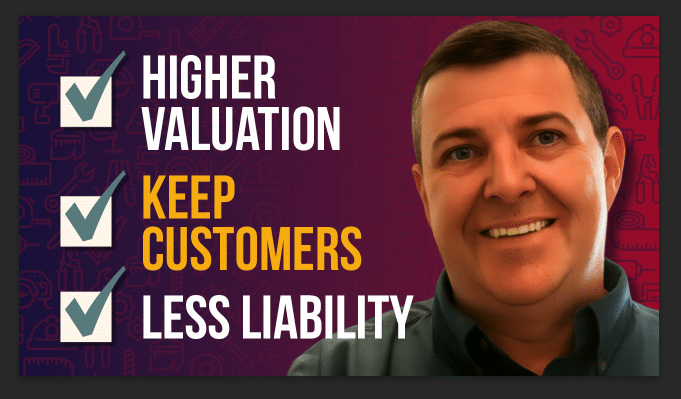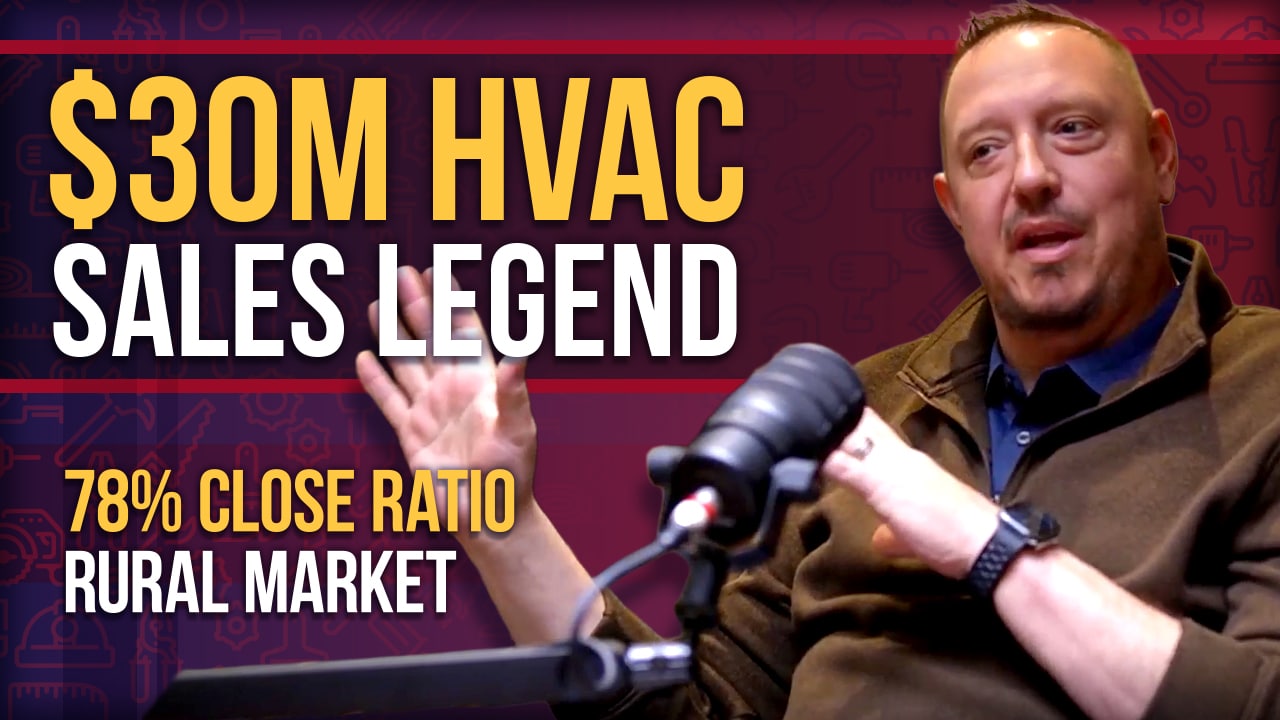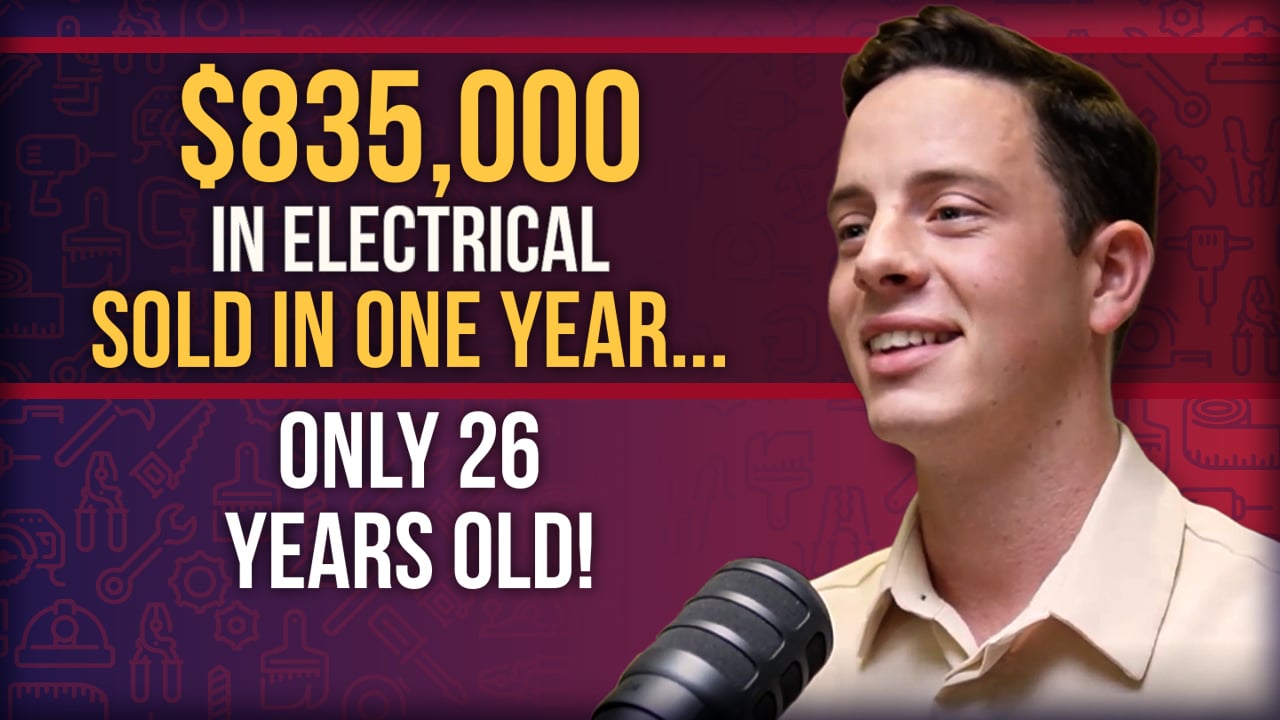Joe Voci & His Team at JDV Electric, Located in Lansdown, PA, Succeed by Delivering Exceptional Service & by Diligently Managing the Busines by the Numbers
This story is an approximate transcription of a “The Successful Contractor” podcast interview. “The Successful Contractor” podcast, powered by Success Group International, is a show for residential contractors about residential contractors. It chronicles business journeys, shares insights, and celebrates successes in this wonderful industry of the trades and tradespeople.
Joe Voci owns and operates JDV Electric in Lansdown, Pennsylvania, which is right outside of Philadelphia. Joe is a reminder of what real success in business is. JDV is a small company—just three trucks—one of which Joes runs. But JDV Electric has managed to grow 40 percent each year, while maintaining a 20-percent net profit or better.
The secret to Joe and JDV Electric’s success is straightforward, like their pricing. Joe and his team invest the time and energy needed to run service calls the right way. They take their time. They diligently inspect the home for safety concerns, build a strong inspection report, create logical options, and then educate homeowners. It’s up to the homeowner to decide how to move forward. And they do to the tune of a companywide average ticket over $1,500 this year.
Sales only paint part of JDV Electric’s portrait of success. Dollars only matter if they manage to hit the bottom line. That’s where Joe has shined with his management of the company. He reviews his KPIs and monthly profit and loss statement adamantly, responding to the information they provide, enabling the company to pivot where necessary on its way to likely hitting its first ever $1 million year.
Joe is deeply proud of his small, but bright and dedicated team, who have been willing to learn and grow along with JDV Electric. And Joe is especially excited to have one of his biggest cheerleaders to be a part of his team full-time these days. “[My dad, Joe Voci, Sr.] has played a huge part in my success,” Joe Jr. said. “I couldn’t have gotten to where I am now without him. Being the owner, sometimes you don’t have anyone to truly hold you accountable. He pushes me to be the best!”
What was the reason for initially joining SGI?
I did a new-construction project, and at the end, we did six brand-new homes and I owed $15,000 on a credit card. It was insane. I can’t go on like this. I saw other companies in my area doing residential service, but I wasn’t sure how to go about it. They appeared to be making money. So, I found SGI, and it’s been a blessing ever since.
I actually first heard about SGI around 2009. I got a postcard. I thought it was too good to be true. I went to a Profit Day™ in 2013, and I still didn’t join up. But in 2015, I went knowing I was definitely signing up. Looking back, I should have joined back in 2009.
After joining, you go to Executive Perspective™. What were two or three changes you knew needed to happen immediately once you got home?
We had to get uniforms and the pricing structure in place. I went to EP in September—October 1st we had our price book and started using it. It took me about six months to get a hang of how to price jobs, making sure that we’re profitable.
Did you attend Learning Alliance’s Service Essentials early on to learn how to best use the price guide?
I went to Service Essentials™ and went to the Advanced Electrician Class™. I learned a lot just from other members, as well. A lot of members helped me learn how to write options and present it to the customer. It’s a process. Once you learn the right way, it works. I think it took me a good year to really get a handle on running the SGI model—and it was just me and a truck. It wasn’t until 2017 that I started hiring people and training them.
Back to pricing, how much did you need to increase your pricing in those early stages?
My first six months after joining, I still wasn’t priced right. Some of that was being afraid. Then I realized, hey, we have to charge what we have to charge to be in business. Ever since, we’ve raised our prices every year. It is what it is.
With the price increases, you’ve also elevated the level of service?
Definitely. We’re in uniforms, do the floor-savers, and use the drop cloths. We go the whole nine yards. We look for opportunities to go above and beyond, whether it’s pulling trash cans back up or grabbing a newspaper. Whatever we can do to help. We wrapped our first truck in 2017, and then we purchased two new vehicles last year and had them wrapped. All of that image helps.
When did you hire someone to answer the phones?
It came after a little time. That should’ve been the first hire. I was relying on a call center or relying on myself to answer the phone. If it’s just one person getting started, you can’t do everything. And most importantly, getting the phones answered is one of the most important things. That’s setting the professional image for your customers calling.
Did you have a service fee when you joined?
We didn’t have a travel fee, but we dabbled around it before SGI. I’d have trouble with it on the phone. Now, we stick to our guys and don’t waive it. It’s tough when we’re slow, but we do whatever we can not to go out for free.
How long did it take you to get comfortable conducting safety inspections?
We do a 10-point safety inspection on our callas, and we started that back in 2017. We use that to build options. Really, we use it to educate the customer, that’s the biggest thing. They don’t know what’s in their home. It’s not sales at that point, it’s just letting them know if they have any dangerous issues and how we can solve those problems.
Do you always do an inspection on every call?
We’re going to do it unless they stop us. And when I train the guys, that is the same thing. You have to make them believe. If they don’t believe that they’re doing a service to the customer, and making sure it’s about the safety of it, they won’t do them. At the end of the day, that’s what is more important—the safety of the customer in their home and around their electrical system. We educate people on everything, on smoke detectors, for example. It does take time. Our average time in the home before travel, even presenting a price, is around 90 minutes. That’s between building rapport with the customer, doing the 10-point safety check, and then we get into pricing.
How do you build your options for customers?
Providing options is definitely an art because you want to make sure that you’re prioritizing things for the customer. We give people an option one, two, and three. Option one is pretty much everything we find on the safety inspection report, plus whatever we were called for there that day—whether it was an install call or something not working. With option two and then three, we’re just taking things away in order of importance. If they don’t have smoke detectors, that’s going to be on option two. We want to do life safety over equipment safety, so we’re going to give them smoke detectors over surge protection.
When did you hire your next electrician?
It was 2017. This individual came in, and I said, “You fit the job criteria—you’re hired.” [Laughter] A few months in, he wasn’t working. I had to find his replacement, unfortunately. He wasn’t suited for service. Good electrician, though. I’ve had to learn how to hire better as I’ve developed as an owner.
What’s your recruiting and hiring process today?
We run ads on Indeed™. Michele will conduct a phone interview. If they pass her test, that person gets passed to me. I’ll do a phone interview and then bring them in for an official interview in the building. I’ll talk to them right away that we drug test, background check, and need clean driver’s records. I make sure they can do the work. I’ll ask some questions about previous job history. Then, I’ll have some behavioral questions, too. You want to see how they think, if they’re quick, and if they have good judgement. We’ve mostly hired experienced electricians, but we do now have our first apprentice.
The experienced electricians you’ve hired, which ones have been the best? Do they fit certain criteria?
Younger guys looking for a change [have been the best for us]. They might be working construction and don’t see a future. Then, it’s training them on how to run service calls because they don’t know. You want people who like the idea of a new challenge every day. Construction can get boring. You want someone who likes meeting new people. They tend to be energetic and happy. They want to serve others.
Once you hire someone, what’s your onboarding process?
SGI a couple years ago rolled out that onboarding program at Expo, which really helped. There’s videos and a workbook. We arrange time in the office for me to get a new person onboard as quickly as we can. We’ll watch some videos for two hours in the morning. Then, the rest of the day, that new person is running service calls with me to actually see it in person. That makes them a believer.
How long does it take for you to feel comfortable to put a new electrician in his own vehicle?
It’s a per-person basis. If I’m confident in his technical ability and communication ability with the customer, I don’t see why we can’t get him out in a four- to six-week period.
We’ve talked hiring and onboarding. What’s the continual training look like at JDV Electric?
We do Tuesdays and Thursdays, and we start training at 7:30, finish up around 8:30. It’ll be a mix of technical training, how to run the service call, how to price jobs. Then just talking with the guys. Hey, what challenges did you have with a certain type of customer? Maybe it’s a landlord tenant call they ran into—how do you deal with this situation? So, we’ll give guidance on that, which gives them confidence. Or if they get to a customer’s house and that customer pulls out an invoice or an estimate from another company, my guys get excited now. I’ve trained them well enough that they’re confident they can just rip apart that estimate, talk about warranties, talk about our value. It’s great. I think that all comes from just having conversations with your guys. They’ll let you know what they need, and you give it to them.
Do you talk to your team much about goals?
I have to do a better job of coaching my guys, honestly. But we do set some goals for them. The last couple of months, I’ve been saying, “This is what we need for you to hit,” whether it’s a monthly goal, broken down to the day. They’re all doing very well, though. We have a company average ticket of a little over $1,500 for the year.
We have a KPI board, so they know exactly where they are. We have a goal of a million dollars in revenue for the year. We broke it down into how many days we have left to hit and how much revenue per day we need. Every day, everybody gets to see it. We’re all fighting hard for it.
I love the idea of making the company goal visual for everyone. It makes it easier for everyone to get behind it.
I let everybody here know that it’s a team effort. It’s not just me. It starts at the phones when Michele’s answering and booking that call. If she doesn’t set that lead and do a great job there, then we don’t get the opportunity. And then if we do get the opportunity, we have to make sure we go out there and shine and give that customer the best experience possible.
What’s your compensation structure like?
Right now, it’s hourly plus commission. Any job over $750 is eligible for commission. They will earn three percent over $750.
You mentioned KPIs. Which KPIs do you talk to your team about regularly?
When I’m training with the guys, we’re talking about conversion rates and average tickets. If their conversion ratio is low, why is that? More than likely, they’re struggling building value. We can see that weakness and train on it. We track our numbers. We get a lot of that stuff from SGI, but I have to mention a huge help has been our Profit Platoon™, as well. We get together once a month for something like three years now. It’s been instrumental to my success and our other members’ success, as well.
Share with people what your Profit Platoon™ meetings look like?
Once a month we rotate who’s getting the visit. And we have an accountability form that we would fill out that helps us dissect the company, so we can see where we can help. There’s nothing like actually going into a person’s business, seeing it firsthand. That’s when you get the full perspective. It’s huge.
Everybody benefits from it no matter what stage because we have companies that are doing over a million dollars; we have companies that are doing over two million; and some companies that are just doing a couple hundred thousand, but everybody can say something. We’re all trying to learn and grow.
How much has the Profit Platoon™ kept you accountable?
It definitely does. I mean, you’re getting help from other members. They’re coming here, and they’re taking time out of their day say, “Hey, these are problem areas that you should work on.” And if you don’t want to take that time and follow their advice, it’s kind of disrespectful in a way, I think, because everybody’s making time to come help you.
How has JDV grown since 2017?
The last three years it’s been 40-percent growth year over year. Our first year with SGI, we did $350,000. Then, we hit $600,000. Then, last year, we finished at $818,000. We were on target for another 40-percent growth until COVID threw us off a bit. We adjusted the goal, so it would be attainable. That’s where our one million came from.
You’ve achieved that growth while maintaining 20-percent net profitability?
For the most part. Last year, our net profit was at 18.5 percent. This year, we’re at 24 percent, year-to-date. I can’t remember where we were three years ago, but I heard loud and clear that the profitability has to be there for the growth to happen. If not, you’re always going to struggle. You don’t have anything to reinvest back into the business.
What’s been your key to maintaining such strong profitability?
The last two years, I’ve really been reviewing my profit-and-loss statement every month, and I have a handle of it. I’m managing my labor and materials costs well. Making sure you’re reviewing that profit-and-loss statement every month is the big thing to making money. You can’t push it off and look every three months, six months, or at the end of the year. You look every month so you can see if you’re off course and where you need to change. Do you have too many people? Are your materials too high? Is my overhead too high? Am I paying for something I shouldn’t?
How have you managed to keep your manpower spending where it needs to be?
I’d be lying if I said I knew exactly. [Laughter] We manage its efficiency well. A lot of our service calls are close to our home office, so we’re not spending a lot of time driving around. I think that helps. But yeah, on average, each guy runs two calls a day. In fact, as a company, I think we’re averaging 1.8 calls a day.
How much do you rely on financing with those larger average tickets?
We offer it on every call. I think between 8 to 10 percent of our total revenue is financed.
You’ve been growing so aggressively. You must have been able to find a bunch of new customers. What are you doing for marketing?
I always make sure to spend around 10 to 11 percent [of total revenue on marketing]. When I started, I didn’t have a large customer base. I had to do the cheapest things possible to find customers. To date, probably a lot of our calls come from Google™ local search ads.
Do you have a club membership to help keep your board full?
I started that right after Expo, that October. I still remember—I sold my first club membership, and then the next day, the lady canceled. [Laughter] I was so happy and then so disappointed. But we probably have around 185 members now.
Fortunately, we haven’t had to lean on that base. We try to get to every member, every year. A lot of time that’s difficult. We make phone calls, send texts, send emails. We try to tie the club membership back with their lifetime warranty—for example, if we’ve replaced their electrical panel. So, they can’t keep that warranty if we can’t check it every year. That’s how we tie it back.
What are your six-month or one-year goals for JDV Electric?
We didn’t hit $1.2 million this year, obviously [with everything going on in the world]. That will be our minimum goal next year. If I can find the technicians, I think $1.5 million is easily obtainable.
Do you have immediate plans of getting out of the field?
I like doing the electrical work, but at times, it burns you out. I’m in the process of working on getting out of the truck. I’ve made my attempts before, I’ve gotten out of the truck, and I get pulled back in. I know I need to keep moving forward to make it happen.
You have a company that’s growing at a great margin. Do you have any parting advice for contractors on how they can enjoy similar success?
The biggest thing for me is make sure that you have your profit-and-loss statement set-up matching the SGI model. Make sure you’re checking those numbers every month. Make sure you’re priced right, so you can then hit that net profit. If you’re not priced right, you’re never going to hit that net profit. So, check with [ESI coach] Sonya [Fryar] and make sure you’re where you need to be. And just constantly review things. Price shop your vendors, make sure you’re where you need to be. I do that once or twice a year. If something seems off, I know I have to make a phone call. You have to keep those margins.




